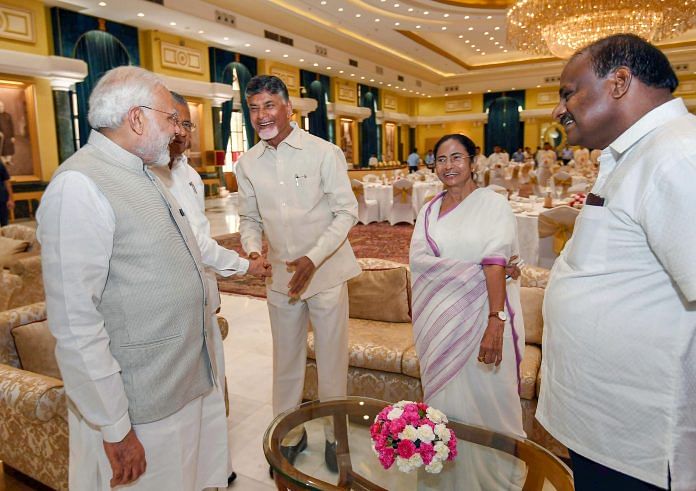The ‘Team India’ concept has not worked as much as Prime Minister Narendra Modi expected, and the Niti Aayog itself is a ‘work in progress.’
The fourth meeting of the governing council of Niti Aayog brought to the fore doubts about whether Prime Minister Narendra Modi’s ‘Team India’ strategy is working on the ground or if it is a mere slogan. It was in his first address to the Rajya Sabha (council of states) in 2014 that Modi laid out his vision for ‘cooperative and competitive’ federalism. The concept was part of the BJP’s 2014 manifesto, which laid emphasis on closer coordination between the Centre and states.
A former chief minister himself, Modi promised a new approach and declared that chief ministers would work together with the Centre to resolve differences. He had also spoken in favour of a more harmonious and meaningful relationship between New Delhi and the states, often lambasting the Planning Commission for not addressing federal needs. He has been chanting this mantra in various fora and repeated it at the Niti Aayog meeting Sunday.
Modi has taken several steps in this direction in the past four years, including reversing the ‘top-to-bottom’ process of planning, and by replacing the Planning Commission with a less powerful Niti Aayog. Its key functions include cooperative federalism and emphasis on greater inputs from outside experts.
However, the Aayog itself is a ‘work in progress’. The Modi government also began ranking states’ business environments, drafting some model laws for them, facilitating them to negotiate loans from abroad, and having new bodies to consult states on domestic and trade policy. Besides, the Modi government accepted the 14th Finance Commission recommendations and increased the states’ share in central taxes from 32 per cent to 42 per cent.
Experts feel that the ‘Team India’ concept has not worked as much as Modi expected, due to various reasons. After the liberalisation and the rise of strong and dynamic regional leaders, the states have become key stakeholders giving rise to a new federal spirit. Decentralised central planning and Modi’s ‘cooperative and competitive federalism’ are part of this new awakening.
The trust deficit between the Centre and the states is not new, as opposition chief ministers have had many grouses against the Centre, including a step-motherly treatment in the allocation of funds. Former prime minister Jawaharlal Nehru had cordial relations with chief ministers during the single-party domination. But former prime minister Indira Gandhi could not tolerate opposition chief ministers. Andhra Pradesh chief minister N.T. Rama Rao even walked out of the National Development Council (NDC) meeting. In recent times, then Tamil Nadu chief minister Jayalalithaa stormed out of the 57th NDC meeting in 2012, complaining that such meetings were pointless.
The mistrust of the CMs continues after the setting up of the 15th Finance Commission because some states are upset about its terms of reference. Reduced share from the Centre and a strong bias against southern states are some of their complaints.
The recent Niti Aayog meeting is a classic example of how some non–NDA CMs felt. The National Development Council and National Integration Council (NIC) were the bodies where chief ministers spoke freely but no such mechanism exists now. The NIC has hardly met since Modi has come to power. Although the GST council is a more powerful body than the Niti Aayog, there are difficulties in holding GST council meetings and arriving at agreements.
As for cooperative federalism, centre-state relations are increasingly becoming politicised. Modi’s relationships with a number of chief ministers have soured due to bitter election campaigns and his intolerance towards non-NDA CMs. On their part, they are less willing to go along, like West Bengal chief minister Mamata Banerjee. They are building a pressure group.
So far, the Niti Aayog has set up three committees to address the concerns of the states. The centre has accepted the recommendations of the committee headed by Madhya Pradesh chief minister Shivraj Singh Chouhan on centrally sponsored schemes. The second, headed by Andhra Pradesh chief minister Chandrababu Naidu on digital issues, has hardly met. After the states confronted the Modi government Sunday on various issues like the 15th Finance Commission report and distribution of central funds, the third committee is being set up on land and farm waivers.
On the positive side, the NDA has 20 chief ministers who are cooperative. The last four years have also witnessed a number of visits by chief ministers to Singapore, China and other countries. International investors’ summits too have become a common state-level feature. Modi took with him chief ministers from Gujarat and Maharashtra during his China visit. The only time he took a non-NDA chief minister was Mamata Banerjee to Bangladesh. The external affairs ministry has set up a separate division to interact with the states.
How can the states be competitive when they have an unequal playing field? Some states are big, some are small, some are rich, some are poor, and there are many other inequalities. Undoubtedly, eastern and northeastern India need a big boost in terms of development. So, the present idea of ‘naming and shaming those states’, which are not doing well, may not be the correct approach. After all, one size does not fit all!
On the whole, while the ‘cooperative and competitive federalism’ may be a good concept, it is likely to be a ‘work in progress’ because of the splintering polity and non-visionary leaders.



